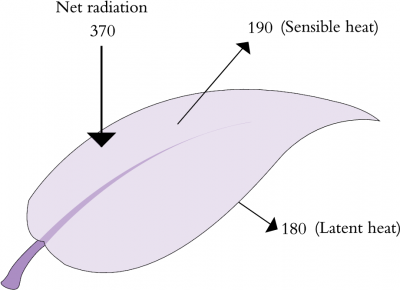All organisms must balance energy inputs and outputs in order to maintain tissue temperatures within a given range. Plants have evolved a range of adaptations that allow them to balance energy gain and loss and so avoid becoming too hot or too cold. Energy budget equations quantify the energy gained and lost through different processes. More complex energy budget models include leaf and canopy properties that influence the rate of energy transfer (see Lambers et al. 2008).
In a leaf energy budget, energy is gained through radiation absorbed, while energy is dissipated as radiant heat loss by emission of longwave radiation, sensible heat loss by convection, and latent heat loss by transpiration (Figure 14.5). For a leaf to maintain a constant temperature the energy exchange must be balanced such that:
Radiation absorbed = radiant heat loss + sensible heat loss + latent heat loss
Energy gain comes primarily from the sun in the form of shortwave radiation. Leaves absorb a large proportion of incident solar shortwave radiation, particularly in the visible wavebands (Figure 14.6). As any object with a temperature above absolute zero emits some radiation, leaves also absorb longwave radiation from their surroundings. A plant can reduce the amount of radiation absorbed by reducing the amount of leaf area exposed to the sun, e.g. by changing leaf orientation or leaf dimensions. Leaf properties such as surface wax, hairs and scales will also alter the amount of incident radiation that is reflected and transmitted (see section 14.7.2).
During the day, thermal energy that is absorbed by a leaf must be dissipated to prevent the leaf from overheating. A large amount of heat is lost through the emission of longwave radiation, but this is normally balanced by inputs of longwave radiation from the surrounding environment. The rate of radiant heat loss is determined by leaf temperature and by leaf emissivity. Emissivity does not vary greatly between leaves; generally darker, smoother leaves have a higher emissivity (as well as a high absorbance) (Lambers et al., 2008). At night time, radiant heat loss can cause leaf temperature to drop well below that of the surrounding air. On long, cloudless nights, when there is little radiant input from the atmosphere, dew can condense on the leaf surface and, in extreme cases, leaves may cool below zero resulting in frost damage.
During the day a leaf typically loses sensible heat to the surrounding air through convection. At night the situation is usually reversed with leaves gaining heat from the surrounding air. The rate at which heat is gained or lost is proportional to the difference in temperature and to the amount of resistance between a leaf and the surrounding air. Characteristics that increase the size of the boundary-layer, e.g. large leaf dimensions or presence of leaf hairs, will reduce the rate of heat exchange. Similarly, reduced wind speed will reduce the rate of sensible heat exchange.
For transpiration to occur, water contained in cells within a leaf must change into water vapour and escape through stomatal pores. For the water to move from a cell to the inter-cellular air space it must change from a liquid to a gas (water vapour). This phase change from liquid to gas consumes a large amount of energy and in doing so cools the leaf. This loss of energy is referred to as latent heat loss. The rate at which transpiration occurs is proportional to the difference in humidity and to the amount of resistance between the inside of the leaf and the surrounding air. As well as wind speed and boundary layer properties, transpiration is strongly influenced by stomatal resistance. When the stomata are closed, heat loss through transpiration is negligible. Although stomatal resistance has a large impact on leaf temperature, it is generally accepted that stomatal opening does not respond directly to changes in temperature. In hot, dry conditions stomata will typically remain closed even when a leaf is overheating (Lambers et al. 2008).
Further Reading
Lambers H, Chapin FS, Pons TL. 2008. Plant physiological ecology. Springer
Nobel PS. 1983. Biophysical plant physiology and ecology.WH Freeman.

